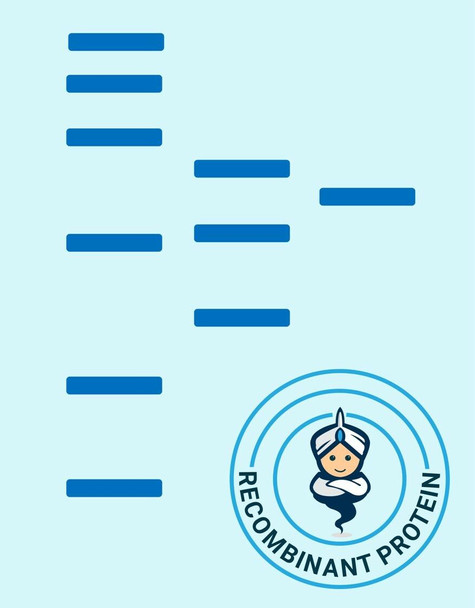Human EDAR Recombinant Protein (RPPB3388)
- SKU:
- RPPB3388
- Product type:
- Recombinant Protein
- Size:
- 20ug
- Species:
- Human
- Target:
- EDAR
- Synonyms:
- Ectodysplasin A Receptor
- DL
- Ectodysplasin 1
- AnhidroticReceptor
- Source:
- Escherichia Coli
- Uniprot:
- Q9UNE0
Description
| Product Name: | Human EDAR Recombinant Protein |
| Product Code: | RPPB3388 |
| Size: | 20µg |
| Species: | Human |
| Target: | EDAR |
| Synonyms: | Ectodysplasin A Receptor, DL, Ectodysplasin 1, AnhidroticReceptor, Anhidrotic Ectodysplasin Receptor 1, Ectodermal Dysplasia Receptor,Ectodysplasin-A Receptor, Downless Homolog, EDA-A1 Receptor, ECTD10A, ECTD10B, EDA3,HRM1, ED3, Tumor Necrosis Factor Receptor Superfamily Member EDAR, Downless,Mouse, Homolog Of, EDA-A1R, EDA1R, ED1R, ED5, Tumor necrosis factor receptorsuperfamily member EDAR. |
| Source: | Escherichia Coli |
| Physical Appearance: | Sterile Filtered clear solution. |
| Formulation: | EDAR protein solution (0.25mg/ml) containing 20mMTris-HCl (pH 8.0) and 10% glycerol. |
| Stability: | Store at 4°C if entire vial will be used within 2-4 weeks. Store, frozen at -20°C for longer periods of time.For long term storage it is recommended to add a carrier protein (0.1% HSA or BSA).Please avoid freeze thaw cycles. |
| Purity: | Greater than 85.0% as determined by SDS-PAGE. |
| Amino Acid Sequence: | MGSSHHHHHH SSGLVPRGSH MGSEYSNCGE NEYYNQTTGL CQECPPCGPG EEPYLSCGYG TKDEDYGCVPCPAEKFSKGG YQICRRHKDC EGFFRATVLT PGDMENDAEC GPCLPGYYML ENRPRNIYGM VCYSCLLAPPNTKECVGATS GASANFPGTS GSSTLSPFQH AHKELSGQGHLATALIIAMS TIFIMAIAIV LIIMFYILKT KPSAPACCTS HPGKSVEAQVSKDEEKKEAP DNVVMFSEKD EFEKLTATPA KPTKSENDAS SENEQLLSRS VDSDEEPAPD KQGSPELCLLSLVHLAREKS ATSNKSAGIQ SRRKKILDVY ANVCGVVEGL SPTELPFDCL EKTSRMLSSTYNSEKAVVKT WRHLAESFGL KRDEIGGMTD GMQLFDRIST AGYSIPELLTKLVQIERLDA VESLCADILE WAGVVPPASQ PHAAS |
Ectodysplasin A Receptor, also known as EDAR belongs to the tumornecrosis factor receptor family. EDAR isa receptor for the soluble ligand ectodysplasin A, and is capable of activatingthe nuclear factor-kappaB, JNK, as well as caspase-independent cell deathpathways. EDAR is necessary for the development of hair, teeth, and otherectodermal derivatives. Furthermore, mutations in EDAR resulted in autosomaldominant and recessive forms of hypohidrotic ectodermal dysplasia.
EDAR Human Recombinant produced in E.Coli is a single,non-glycosylated polypeptide chain containing 445 amino acids (27-448 a.a) andhaving a molecular mass of 48.2kDa. EDAR is fused to a 23 amino acid His-tag at N-terminus& purified by proprietary chromatographic techniques.
| UniProt Protein Function: | EDAR: Receptor for EDA isoform A1, but not for EDA isoform A2. Mediates the activation of NF-kappa-B and JNK. May promote caspase-independent cell death. Defects in EDAR are a cause of ectodermal dysplasia anhidrotic (EDA); also known ectodermal dysplasia hypohidrotic autosomal recessive (HED). Ectodermal dysplasia defines a heterogeneous group of disorders due to abnormal development of two or more ectodermal structures. EDA is characterized by sparse hair (atrichosis or hypotrichosis), abnormal or missing teeth and the inability to sweat due to the absence of sweat glands. Defects in EDAR are the cause of ectodermal dysplasia type 3 (ED3); also known as ectodermal dysplasia hypohidrotic autosomal dominant or EDA3. ED3 is an autosomal dominant condition characterized by hypotrichosis, abnormal or missing teeth, and hypohidrosis due to the absence of sweat glands. |
| UniProt Protein Details: | Protein type:Receptor, misc.; Membrane protein, integral Chromosomal Location of Human Ortholog: 2q13 Cellular Component: apical part of cell; plasma membrane; integral to membrane Molecular Function:protein binding; transmembrane receptor activity; receptor activity Biological Process: epidermis development; pigmentation; hair follicle development; apoptosis; positive regulation of NF-kappaB import into nucleus; cell differentiation; signal transduction; odontogenesis of dentine-containing teeth Disease: Hair Morphology 1; Ectodermal Dysplasia 10a, Hypohidrotic/hair/nail Type, Autosomal Dominant; Ectodermal Dysplasia 10b, Hypohidrotic/hair/tooth Type, Autosomal Recessive |
| NCBI Summary: | This gene encodes a member of the tumor necrosis factor receptor family. The encoded transmembrane protein is a receptor for the soluble ligand ectodysplasin A, and can activate the nuclear factor-kappaB, JNK, and caspase-independent cell death pathways. It is required for the development of hair, teeth, and other ectodermal derivatives. Mutations in this gene result in autosomal dominant and recessive forms of hypohidrotic ectodermal dysplasia. [provided by RefSeq, Jul 2008] |
| UniProt Code: | Q9UNE0 |
| NCBI GenInfo Identifier: | 21263572 |
| NCBI Gene ID: | 10913 |
| NCBI Accession: | Q9UNE0.1 |
| UniProt Related Accession: | Q9UNE0 |
| Molecular Weight: | |
| NCBI Full Name: | Tumor necrosis factor receptor superfamily member EDAR |
| NCBI Synonym Full Names: | ectodysplasin A receptor |
| NCBI Official Symbol: | EDAR |
| NCBI Official Synonym Symbols: | DL; ED3; ED5; ED1R; EDA3; HRM1; EDA1R; ECTD10A; ECTD10B; EDA-A1R |
| NCBI Protein Information: | tumor necrosis factor receptor superfamily member EDAR |
| UniProt Protein Name: | Tumor necrosis factor receptor superfamily member EDAR |
| UniProt Synonym Protein Names: | Anhidrotic ectodysplasin receptor 1; Downless homolog; EDA-A1 receptor; Ectodermal dysplasia receptor; Ectodysplasin-A receptor |
| Protein Family: | Tumor necrosis factor receptor superfamily |
| UniProt Gene Name: | EDAR |
| UniProt Entry Name: | EDAR_HUMAN |










